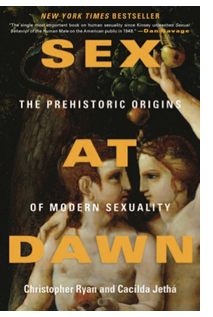| Sun | Mon | Tue | Wed | Thu | Fri | Sat |
|---|---|---|---|---|---|---|
| 1 | 2 | 3 | 4 | 5 | ||
| 6 | 7 | 8 | 9 | 10 | 11 | 12 |
| 13 | 14 | 15 | 16 | 17 | 18 | 19 |
| 20 | 21 | 22 | 23 | 24 | 25 | 26 |
| 27 | 28 | 29 | 30 | 31 |
CATEGORIES
RECENT ENTRIES
BLOG ROLL
Sex at dawn
The case against the “Flintstonization of prehistory.”
In Sex at Dawn: The Prehistoric Origins of Modern Sexuality (HarperCollins, 2010), husband-and-wife coauthors Christopher Ryan and Cacilda Jethá assert that “contemporary scientific speculation concerning prehistoric human life is often distorted by assumptions that seem to make perfect sense.” There are two things—food and sex—that humans experience so personally that we project our relationship with them onto our “nature,” and therefore onto our ancient ancestors, rather than recognize them as cultural, Ryan said last Thursday at an event organized by the student group Out in Public Policy and cohosted by  the Office of LGBTQ Student Life and the Center for Gender Studies. Ryan, a psychologist, and Jethá, a practicing psychiatrist and former AIDS researcher, examine this phenomenon in the chapter “The Flintstonization of Prehistory,” where they argue such assumptions “can lead us far from the path to truth.” Contrary to the standard narrative that projects a conception of nuclear families built around monogamous couples onto our prehistoric ancestors, they argue that humans evolved in interdependent, promiscuous groups.
the Office of LGBTQ Student Life and the Center for Gender Studies. Ryan, a psychologist, and Jethá, a practicing psychiatrist and former AIDS researcher, examine this phenomenon in the chapter “The Flintstonization of Prehistory,” where they argue such assumptions “can lead us far from the path to truth.” Contrary to the standard narrative that projects a conception of nuclear families built around monogamous couples onto our prehistoric ancestors, they argue that humans evolved in interdependent, promiscuous groups.
The basis for their argument is found in primatology, particularly of our closest living relatives, bonobos and chimpanzees, as well as anthropology, comparative anatomy, psychosexuality, and logical deduction. All signs, they write, point to a case for prehistoric humans’ sexual behavior being very different than that of modern humans, or at least of that depicted in the “standard narrative.” Although humans are equally related to chimpanzees and bonobos, comparative anatomy points to greater sexual similarity to bonobos, the highly endangered “forgotten ape” living only in the Democratic Republic of the Congo. Bonobos live in complex, matriarchal, and promiscuous groups, operate a “sharing-based economy,” and use sex to defuse conflicts, among many other uses. Perhaps as a result, violence is very rare, and no bonobo has ever been observed killing another, a relatively common occurrence in chimpanzee—and human—society.
At the campus event, held at 5710 S. Woodlawn, home of the Offices of LGBTQ Student Life and Multicultural Student Affairs, Ryan was quick to point out that the book is not meant to be prescriptive. Although it describes humans as naturally non-monogamous, Ryan was quick to point out that they are not advocating against monogamy as a choice, despite offers from publishers to put out a book doing so. He and Jethá’s intent was only to write a realistic exploration of sexuality in prehistory, based on the best scientific evidence available. Despite that academic bent, the book has reached No. 24 on the New York Times bestseller list for hardcover nonfiction, and a paperback release has been announced for July, 2011. Sex at Dawn has already found an audience on campus; turnout for the event was clearly larger than organizers expected, with a standing-room-only crowd of more than 100 spilling out of the room and down the hallway.
Kyle Gorden, AB'00
November 9, 2010
